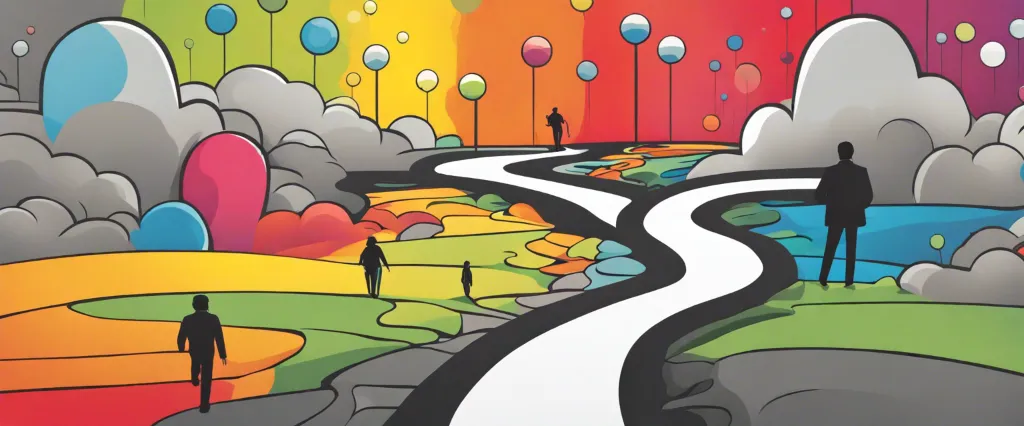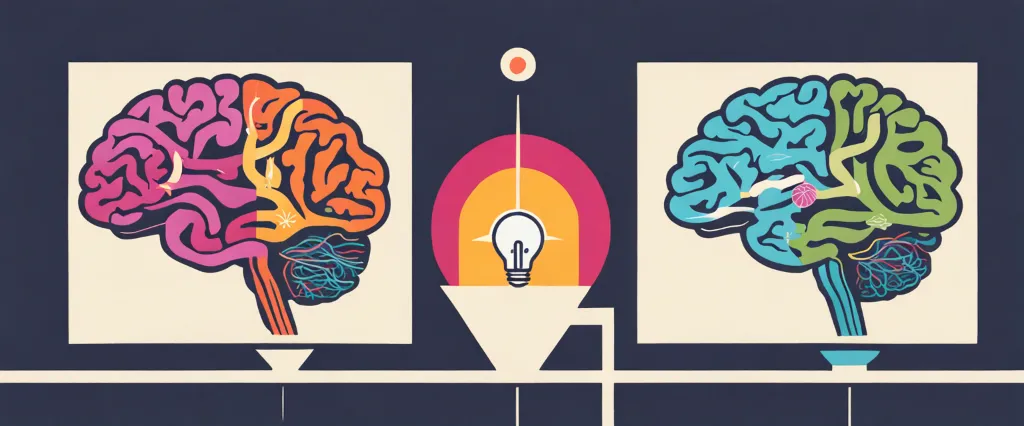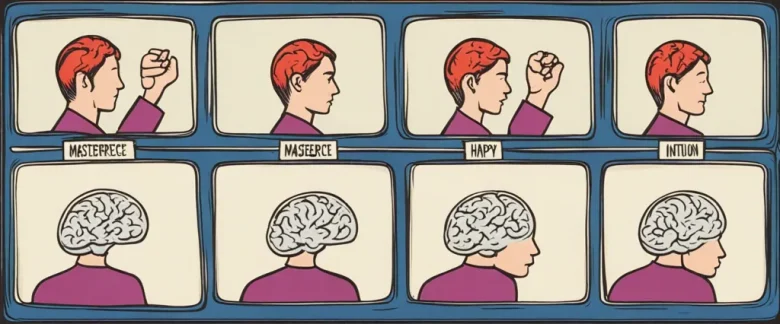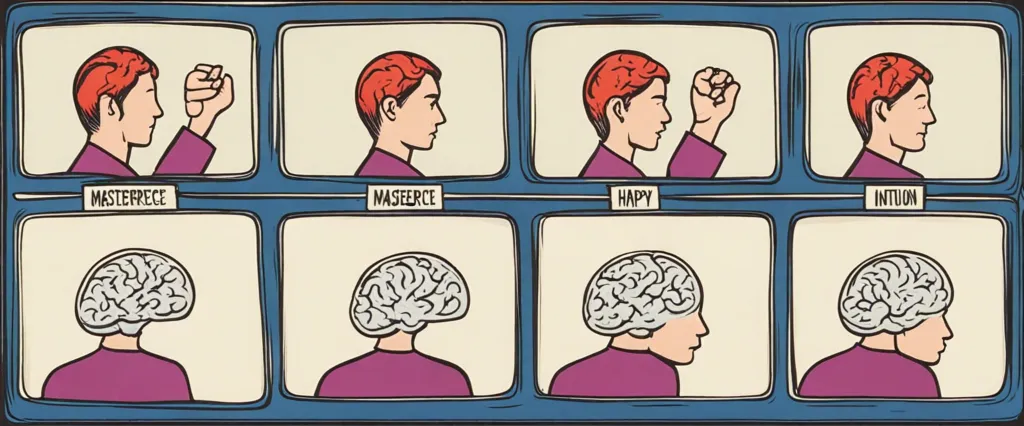In “What Makes Your Brain Happy and Why You Should Do the Opposite,” David DiSalvo delves into the fascinating world of neuroscience to uncover the hidden forces that shape our thoughts, emotions, and behaviors. Through a thought-provoking exploration, the author reveals how our brains are wired to deceive us, leading us to make irrational decisions and fall prey to various cognitive biases. With a focus on providing practical advice, DiSalvo presents counterintuitive strategies that challenge our ingrained patterns and guide us towards making wiser choices. Armed with this knowledge, readers can better navigate the complexities of their own minds. David DiSalvo is an accomplished writer and researcher, recognized for his insightful studies on psychology, science, and technology. As a regular contributor to prominent publications and the author of multiple acclaimed books, DiSalvo brings a wealth of knowledge and expertise to shed light on the inner workings of the brain and how we can harness its potential for a happier and more fulfilling life.
Chapter 1: The Brain’s Default Setting – Exploring the brain’s natural tendency to seek comfort and familiarity, and how this default setting can hinder personal growth and happiness.
Chapter 1 of “What Makes Your Brain Happy and Why You Should Do the Opposite” by David DiSalvo delves into the concept of the brain’s default setting. The author explores the innate tendency of the brain to seek comfort and familiarity, which can hinder personal growth and happiness.
DiSalvo explains that the brain is wired to conserve energy and avoid unnecessary risks. It naturally gravitates towards familiar routines and behaviors that require minimal effort. While this default mode served humans well in the past by helping them survive and adapt, it can be problematic in modern society.
The author emphasizes that stepping out of one’s comfort zone and embracing change is essential for personal growth and happiness. However, the brain’s inclination towards the familiar can create a resistance to change. Consequently, individuals often find themselves stuck in ruts, experiencing a lack of personal development and fulfillment.
DiSalvo also introduces the concept of cognitive biases, which are a result of the brain’s default setting. These biases can influence how individuals perceive and interpret information, often leading to irrational or flawed thinking. Awareness of these biases can help individuals overcome them, enabling better decision-making and a more open-minded approach to new experiences.
The chapter concludes by highlighting the importance of actively challenging one’s default setting to foster personal growth and happiness. By recognizing and pushing past the brain’s natural inclination towards comfort and familiarity, individuals can open themselves up to new possibilities, learn from different perspectives, and ultimately lead more fulfilling lives.
In summary, Chapter 1 explores the brain’s default setting, which is geared towards seeking comfort and familiarity. It explains how this default mode can hinder personal growth and happiness, limiting individuals to familiar routines and thoughts. The author emphasizes the need to overcome these tendencies, embrace change, and challenge cognitive biases to lead a more fulfilling life.
Chapter 2: The Illusion of Certainty – Examining how the brain craves certainty and resists uncertainty, and how embracing ambiguity and taking risks can lead to greater fulfillment.
Chapter 2 of “What Makes Your Brain Happy and Why You Should Do the Opposite” by David DiSalvo is titled “The Illusion of Certainty – Examining how the brain craves certainty and resists uncertainty, and how embracing ambiguity and taking risks can lead to greater fulfillment.” In this chapter, DiSalvo explores the human brain’s predisposition for seeking certainty and avoiding uncertainty.
DiSalvo begins by explaining that the brain’s craving for certainty originates from an evolutionary need to reduce threats and ensure survival. Uncertainty is perceived as risky, and the brain’s natural response is to seek certainty to minimize potential dangers. However, DiSalvo warns that excessive certainty-seeking can lead to stagnation, missed opportunities, and unhappiness.
The chapter delves into various cognitive biases that contribute to the illusion of certainty. One such bias is the confirmation bias, where individuals tend to seek out information that supports their preexisting beliefs, reinforcing certainty and hindering open-mindedness. Additionally, individuals often fall prey to the hindsight bias, which distorts their perception of past events to make them seem more predictable than they actually were.
DiSalvo suggests that embracing ambiguity and taking calculated risks can lead to greater fulfillment in life. By understanding that certainty is often illusory, individuals can develop a mindset that allows for flexibility and adaptability. Embracing uncertainty opens doors to new experiences, personal growth, and a more creative approach to problem-solving.
The chapter concludes with practical strategies to counter the brain’s natural aversion to uncertainty. DiSalvo encourages readers to challenge their assumptions, entertain multiple perspectives, and cultivate a willingness to engage with the unknown. He emphasizes that stepping outside of one’s comfort zone and embracing ambiguity can lead to a more satisfying and fulfilling life.
In summary, Chapter 2 of “What Makes Your Brain Happy and Why You Should Do the Opposite” explores the brain’s craving for certainty and resistance to uncertainty. It highlights the cognitive biases that reinforce the illusion of certainty while emphasizing the benefits of embracing ambiguity and taking risks. By challenging the brain’s natural aversion to uncertainty, individuals can harness its potential for personal growth and fulfillment.
Chapter 3: The Power of Novelty – Discussing the brain’s response to novelty and the benefits of seeking out new experiences and learning opportunities for cognitive enhancement and happiness.
Chapter 3 of “What Makes Your Brain Happy and Why You Should Do the Opposite” by David DiSalvo explores the power of novelty in enhancing cognitive abilities and happiness. The chapter delves into the brain’s response to novelty, discussing how our brains are wired to seek out new experiences and how these experiences can greatly benefit us.
DiSalvo begins by explaining that novelty acts as a stimulant for the brain, releasing dopamine, a neurotransmitter associated with pleasure and reward. This dopamine release not only makes us feel good but also enhances learning and memory. The author further explores the concept of the brain’s “novelty bias,” which suggests that our brains are naturally inclined to pay more attention to new or unfamiliar information, making it easier for us to learn and retain knowledge.
The chapter also emphasizes the importance of seeking out new experiences and learning opportunities for cognitive enhancement and happiness. DiSalvo argues that engaging in novel and challenging activities promotes the growth of neural connections in the brain, thus enhancing cognitive abilities such as problem-solving, creativity, and critical thinking. Additionally, the pursuit of novelty can lead to a sense of fulfillment and satisfaction, contributing to overall happiness and well-being.
Throughout the chapter, DiSalvo provides numerous examples and studies to support his points, including research on the benefits of traveling, learning new skills, and embracing change. Overall, Chapter 3 emphasizes the profound impact that novelty has on our brains, highlighting the significance of actively seeking out new experiences and learning opportunities to enhance cognitive functioning and cultivate happiness.
Chapter 4: The Social Brain – Exploring the brain’s social nature and the importance of social connections for overall well-being, highlighting the need for genuine social interactions in the age of technology.

Chapter 4 of “What Makes Your Brain Happy and Why You Should Do the Opposite” by David DiSalvo explores the social nature of the brain and underscores the significance of social connections for overall well-being. The chapter emphasizes the need for genuine social interactions, especially considering the pervasive influence of technology in today’s society.
DiSalvo highlights how humans are wired to be social creatures, and our brains have evolved to prioritize social interactions. He discusses the research that reveals the vital role social connections play in shaping our emotions, decision-making, and even physical health. Studies show that people with robust social networks tend to have higher life satisfaction, longevity, and better overall mental health compared to those who experience social isolation.
However, in the age of technology, traditional face-to-face social interactions have been largely replaced by digital communication platforms. While technology provides us with convenience and instantaneous communication, it often lacks the depth and quality of genuine social interactions. DiSalvo warns that excessive reliance on technology may lead to a decline in social skills, empathy, and a sense of belonging.
The chapter stresses the importance of balancing digital communication with meaningful, in-person connections. DiSalvo provides tips for cultivating genuine social interactions, such as making time for face-to-face conversations, practicing active listening and empathy, and getting involved in community activities.
In conclusion, Chapter 4 underscores the intrinsic social nature of the brain, emphasizing the need for genuine social interactions for overall well-being. It highlights the potential negative consequences of excessive reliance on technology for social connections and encourages finding a balance between digital communication and in-person relationships.
Chapter 5: The Paradox of Control – Examining the brain’s desire for control and how excessive control can lead to stress and unhappiness, emphasizing the value of letting go and embracing flexibility.
Chapter 5 of the book “What Makes Your Brain Happy and Why You Should Do the Opposite” by David DiSalvo explores the paradoxical relationship between the brain’s desire for control and how excessive control can lead to stress and unhappiness. The chapter emphasizes the value of letting go and embracing flexibility as a means to achieve greater well-being.
DiSalvo begins by discussing how the brain is hardwired to seek control. It is driven by the need for certainty and predictability to ensure survival. However, in the modern world where control over various aspects of life is often limited, the brain’s desire for control can become a source of stress and dissatisfaction.
The chapter delves into research on the impact of excessive control on the brain and body. It highlights how the pursuit of control can lead to chronic stress, anxiety, and unhappiness. People who constantly strive for control are more prone to experience negative emotions, as they become fixated on outcomes and fear potential losses.
To counterbalance this paradox, DiSalvo suggests adopting a mindset of letting go and embracing flexibility. He explores the concept of “non-attachment,” which involves releasing the need to control every outcome and accepting the inherent uncertainty of life. By relinquishing excessive control, individuals can experience a sense of liberation, reduced stress, and increased satisfaction.
The chapter also introduces various strategies to cultivate flexibility, such as mindfulness practices, reframing thoughts, and developing an open-minded approach to new experiences. By flexing the brain’s control muscles and embracing uncertainty, individuals can improve their well-being and find greater contentment.
In summary, Chapter 5 of “What Makes Your Brain Happy and Why You Should Do the Opposite” examines the brain’s desire for control and its negative repercussions. It highlights the importance of letting go and embracing flexibility as a means to reduce stress and increase happiness. By adopting a mindset of non-attachment and actively practicing flexibility, individuals can find greater peace and contentment in an uncertain world.
Chapter 6: The Happiness of Giving – Discussing the brain’s response to acts of kindness and generosity, and how altruism and compassion can increase personal happiness and fulfillment.
Chapter 6 of “What Makes Your Brain Happy and Why You Should Do the Opposite” by David DiSalvo explores the concepts of kindness, generosity, altruism, and compassion and how they can impact personal happiness and fulfillment. The chapter delves into the brain’s response to acts of kindness and the psychological benefits they can offer.
The author highlights a study conducted by neuroscientists where participants were given money to either keep for themselves or donate to a charity of their choice. Interestingly, the participants who chose to donate experienced greater happiness and satisfaction than those who kept the money. This suggests that acts of giving activate certain areas of the brain associated with pleasure and positive emotions.
DiSalvo explains that the human brain is wired to reward acts of kindness and generosity. When we engage in altruistic behavior, our brain releases neurotransmitters like dopamine and oxytocin, which promote feelings of joy and well-being. The author emphasizes that these positive experiences can become addictive, encouraging individuals to engage in repeated acts of kindness.
Moreover, the chapter discusses how compassion plays a crucial role in happiness. Compassion involves acknowledging the suffering of others and showing empathy and kindness towards them. By cultivating a compassionate mindset, individuals not only increase the well-being of others but also enhance their own happiness and fulfillment.
In conclusion, Chapter 6 delves into the brain’s response to acts of kindness, generosity, altruism, and compassion. It emphasizes that engaging in these behaviors can trigger pleasurable brain responses and lead to increased personal happiness and fulfillment. Understanding the neural mechanisms behind the happiness of giving highlights the importance of incorporating acts of kindness and compassion into our lives.
Chapter 7: The Power of Mindfulness – Exploring the practice of mindfulness and its ability to rewire the brain for greater happiness, focusing on being present and cultivating gratitude.
Chapter 7 of “What Makes Your Brain Happy and Why You Should Do the Opposite” by David DiSalvo delves into the power of mindfulness and its impact on rewiring the brain for greater happiness. The author explores the practice of being present and cultivating gratitude as key aspects of mindfulness.
DiSalvo begins by explaining that mindfulness involves intentionally focusing one’s attention on the present moment without judgment. He highlights studies that have shown mindfulness to decrease stress, improve cognitive function, and increase overall well-being. The chapter emphasizes the idea that mindfulness is not about escaping difficult emotions or situations but rather understanding and accepting them.
The author discusses the concept of neuroplasticity, which suggests that the brain is malleable and can change its structure and function. Research indicates that mindfulness plays a significant role in triggering neuroplastic changes, leading to increased happiness. DiSalvo explains that practicing mindfulness can help rewire the brain’s default mode network, responsible for mind wandering and self-referential thoughts, towards a more present-focused state.
In addition to being present, cultivating gratitude is another crucial aspect of mindfulness. The author discusses studies that demonstrate how gratitude activates regions of the brain associated with happiness and well-being. By actively fostering gratitude, individuals can counteract negativity biases and focus on the positive aspects of their lives.
Overall, Chapter 7 highlights how mindfulness can reshape the brain for greater happiness by staying present and cultivating gratitude. By intentionally directing attention and focusing on the positive aspects of life, individuals can rewire their brains to experience increased contentment and overall well-being.

Chapter 8: The Pursuit of Happiness – Summarizing the key insights from the book and providing practical strategies for actively pursuing happiness by challenging the brain’s default settings and embracing behaviors that go against its natural inclinations.
Chapter 8 of “What Makes Your Brain Happy and Why You Should Do the Opposite” by David DiSalvo is titled “The Pursuit of Happiness.” In this chapter, the author explores the key insights from the book and provides practical strategies for actively pursuing happiness by challenging the brain’s default settings.
DiSalvo emphasizes that the brain’s default settings often lead to negative emotions and behaviors. However, by understanding the brain’s natural inclinations and actively choosing to go against them, individuals can increase their overall happiness.
One important insight is that the brain tends to focus on potential threats and negative information, a phenomenon known as the “negativity bias.” This bias served an evolutionary purpose but can lead to unnecessary anxiety and stress in modern society. To counteract this bias, the author recommends consciously seeking out positive information and experiences that can balance the brain’s natural tendencies.
Another key insight is that the brain is wired for immediate gratification, often prioritizing short-term pleasure over long-term happiness. DiSalvo suggests practicing delayed gratification and pursuing activities that provide lasting fulfillment.
The chapter also explores the concept of mindfulness, which involves being present and fully engaged in the current moment. By practicing mindfulness, individuals can break free from automatic and habitual thought patterns that contribute to unhappiness.
Practical strategies provided in this chapter include cultivating gratitude, engaging in acts of kindness, setting and pursuing meaningful goals, and focusing on building and maintaining positive relationships.
In summary, DiSalvo’s book highlights the importance of actively pursuing happiness by challenging the brain’s default settings. By understanding the brain’s natural inclinations and implementing practical strategies, individuals can rewire their brains to experience more happiness and fulfillment in their lives.
After Reading
In “What Makes Your Brain Happy and Why You Should Do the Opposite,” David DiSalvo explores the fascinating world of cognitive biases and how they often lead us astray in our decision-making and perceptions. The book delves into the underlying reasons behind our flawed thinking patterns and offers practical strategies to overcome them. DiSalvo emphasizes the importance of critical thinking, self-awareness, and questioning our assumptions to counteract the brain’s natural tendencies. By understanding the biases that manipulate our thoughts and actions, we can make more informed choices, improve our relationships, and lead a more fulfilling life. Overall, DiSalvo’s work shines a light on the complexities of the human brain and empowers readers to challenge their own mental shortcuts, ultimately paving the way for personal growth and intellectual clarity.
1. Thinking, Fast and Slow” by Daniel Kahneman:
In this thought-provoking book, Nobel laureate Daniel Kahneman delves into the mind’s two systems of thinking: the intuitive, fast-thinking system and the slower, deliberate system. He offers insights into how biases, heuristics, and cognitive illusions shape our decision-making processes.
2. Emotional Intelligence: Why It Can Matter More Than IQ” by Daniel Goleman:
Daniel Goleman explores the concept of emotional intelligence (EQ) and its impact on our personal and professional lives. Drawing on scientific research, Goleman argues that EQ plays a far greater role in shaping our success and happiness than traditional intelligence.
3. Influence: The Psychology of Persuasion” by Robert B. Cialdini:
Robert Cialdini unravels the psychology behind persuasion and compliance, shedding light on the tactics used by skilled influencers. Through engaging stories and examples, Cialdini explores the hidden forces that drive our decision-making and how we can protect ourselves from manipulation.
4. Nudge: Improving Decisions About Health, Wealth, and Happiness” by Richard H. Thaler and Cass R. Sunstein:
This book introduces the concept of “nudging” – employing subtle changes to influence behavior positively. Thaler and Sunstein delve into how small, mindful design changes in our surroundings can lead to more desirable decision-making outcomes.
5. The Paradox of Choice: Why More Is Less” by Barry Schwartz:
Barry Schwartz questions the commonly held belief that more choices lead to greater happiness. Examining the psychological and social aspects of decision-making, Schwartz argues that an abundance of choices can often lead to anxiety, dissatisfaction, and paralysis.
These five books offer a captivating exploration of the complexities of the human mind, touching on topics such as biases, emotions, persuasion, decision-making, and the paradox of choice. Each of these recommendations provides valuable insights into understanding our thoughts, behaviors, and the factors influencing them.




